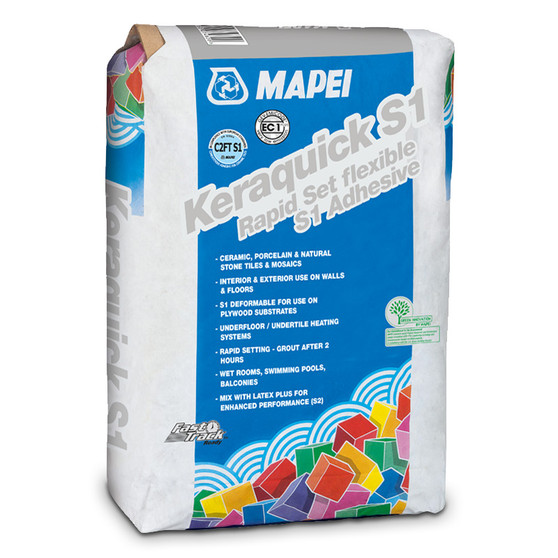Product Description
High-performance, quick-setting, deformable cementitious adhesive with no vertical slip for ceramic tiles and stone material stable in the presence of humidity (thickness of adhesive up to 10 mm). With very low emission of volatile organic compounds.
Bonding to cement-based and calcium sulphate based screeds, concrete, plywood overlay, existing unglazed ceramic floor tiles, cement-based renders, gypsum plaster, plasterboard, tilebacker boards.
For interior and exterior use.
For the installation of ceramic and porcelain tiles and mosaics. For natural stone not sensitive to moisture.
Suitable for the installation of glass tiles and mosaics. Mix with Latex Plus where the glass has a coating on the rear.
For the installation of insulating materials such as expanded and extruded polystyrene panels, gypsum boards, glass and Rockwool, Eraclit®, aerated concrete blocks, sound deadening panels.
Substrates must be dry, flat, mechanically strong, sound, free from loose areas, grease, oil, paint, wax, old flooring adhesive and bitumen residues, and any other contamination (e.g. plaster droppings), which may affect the adhesion. Damp substrates may lengthen Keraquick S1’s setting time. Cementitious substrates must be cured and any shrinkage process must be at an end before tiles are installed. Renders should be cured for at least 2 weeks, concrete at least 6 weeks old, cement-based screeds for at least 3 weeks unless they have been produced using the special MAPEI binders Mapecem or Topcem or with a preblended screed mix such as Mapecem Pronto or Topcem Pronto. The substrate surface should ideally be open-textured. Powerfloated concrete should be mechanically abraded (scabbled or shot-blasted) to open up the surface and to remove any curing agents. Heated screeds must be commissioned in accordance with recognized technical regulations and the guidelines given in BS 5385 parts 4 and 5. The commissioning process must be carried out before the installation of tiles or stone finishes. Gypsum plaster should be at least 4 weeks old and primed with Primer G. Note: over-trowelled plaster surfaces should be lightly abraded to provide a key before priming. Calcium sulfate screeds must be dry to a moisture content of 0.5% w/w when measured using the carbide method. All surface laitance must be removed by mechanical abrasion and all dust thoroughly removed by vacuum. Prime the surface with Eco Prim T (diluted 1:2 with water) or alternatively Primer G. Plasterboard and tile backer boards must be installed to provide a firm, stable substrate with no protruding fixings. Plywood must be a minimum of 15 mm thick and screw fixed at maximum of 200 mm centers on walls and 300 mm centers on floors. It should be of class 3 in accordance with EN 314 and EN 636. Steel substrates must be well braced to provide deflection free support. Remove all rust, mould oil, grease, and other contamination. Apply a skim / scratch coat of Keraquick S1 mixed with Latex Plus and allow to set, then fix the tiles in a void-free bed of the same product.
Pot life of mix: 30 minutes.
Open time: 20 minutes.
Waiting time before grouting: 2-3 hours.
Set to light foot traffic: approx. 2-3 hours.
Ready for use: approx. 24 hours (3 days for basins and swimming pools).
Deformability according to EN 12004: S1 - deformable.
Storage: 12 months.
Consumption: 2-5 kg/m².







